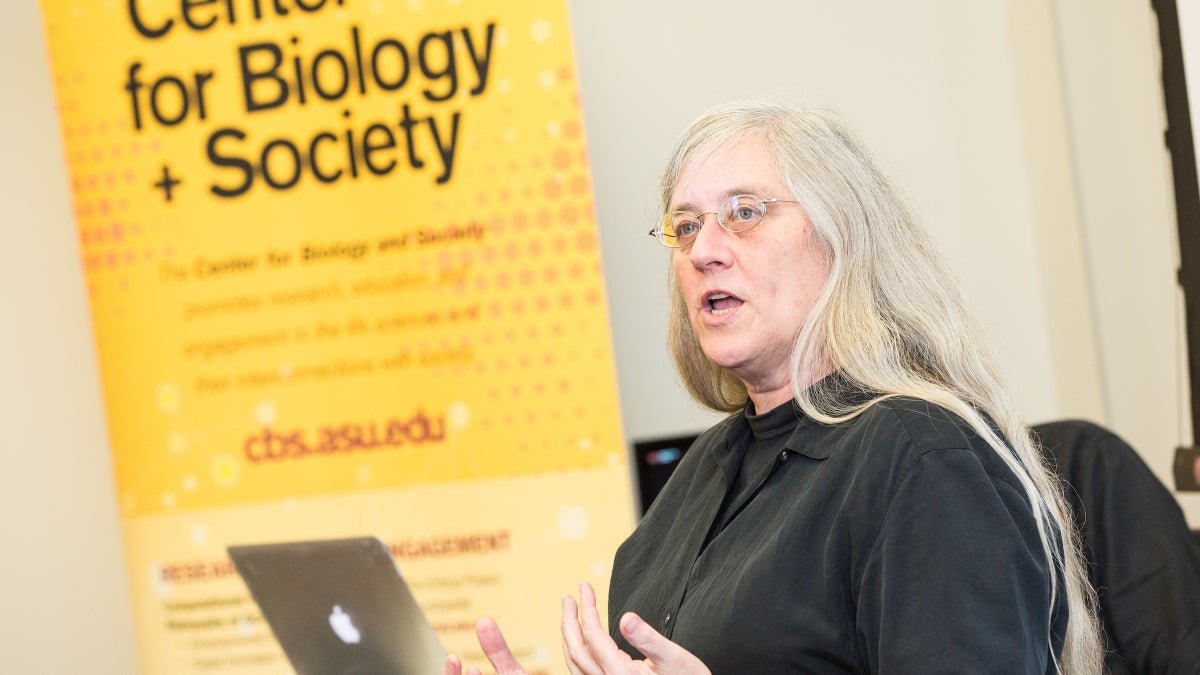The scientist was deep into his lecture. He spoke quickly, using a stream of long words. He disparaged people he didn't agree with. He had an imposing beard.
“This leads to two central processes of extended evolution,” he said, before continuing with a phrase that included the words “… spatial temporal sequence of regulatory states …”
That’s science. Interpreting such phrases in a way that welcomes people into the world of science is communication. And the Center for Biology and Society program in the School of Life Sciences at Arizona State University is celebrating 20 years of bridging those two disciplines.
Author Lydia Pyne earned a doctorate from the center in 2008.
“That’s a rough phrase,” said Pyne, whose latest book, "Seven Skeletons: The Evolution of the World's Most Famous Human Fossils," takes a look at finds such as Lucy, Piltdown Man, the Taung child, and the Indonesian “hobbits” of Flores Island, examining them from discovery to museum display to their legacies in pop culture.
She weaves in the Beatles, Charles Darwin, Arthur Conan Doyle, Stanley Kubrick, Richard Leakey, J.R.R. Tolkien and Ayn Rand, along with journeys to archives, caves, and a fascinating hominid vault at a South African university.
Her degree from the center allows her to bridge a lot of worlds.
“I look at the wide range of topics I work with, and I realize a program like Biology and Society created an environment about students to be excited about a lot of subjects,” Pyne said. “It was almost like you were bilingual in history and science, and I appreciated the duality in the program.”
Center founder Jane MaienscheinMaienschein is also an ASU University Professor, Regents’ Professor, President’s Professor and Parents Association Professor. said a degree from the center plants a foot in the science communication world.
“When students come to us and say, ‘What I can do with this degree?,’ I say ‘Everything,’” Maienschein said. “You can find a niche, if you look and have the confidence. The goal is to help everyone find a niche.”
It’s not a watered-down biology degree. It’s more than biology. “Not everyone can do that,” she said. “There are relatively few people in the country who are getting that education.”
Cornell has a program with some parallels, but ASU is the only university that confers a degree combining the two disciplines.
“Most of the programs are the society side or the science side, but not putting them together in a formal way,” Maienschein said. “I don’t know of anywhere that quite does all that.”
Scanning contemporary non-fiction shelves (bookshelves are another topic Pyne has written about), it’s easy to see the trend the center foreshadowed. Books about historical events such as "In the Heart of the Sea," "The Perfect Storm," and "The Lost City of Z" rely on science as much as archives and libraries. Having a physiologist explain what extreme thirst or drowning does to the human body puts a whole new perspective on events.
The interdisciplinary trend in non-fiction “is wonderful,” Pyne said. “Having that kind of perspective and being really interested in finding a lot of perspectives is going to be helpful for creating a successful book.”
Pyne had a background in paleoanthropology and archaeology, with bachelor’s degrees in anthropology and history.
“I realized by the time I got to grad school I realized the questions I was interested in exploring were better suited to a program like Biology and Society,” she said. It was a perfect fit for what she eventually delved into: “an emphasis on a familiarity with the language of science and the practice of science that could complement historical enquiry.”
As Maienschein pointed out, grads can find a lot of niches. Some have headed into academia. One is head of education and research at a Toronto blindness nonprofit. Others have gone into health and policy work.
The catalyst behind the center were public discussions about biology 20 years ago, when headlines about stem cell research, the human genome project, and Dolly the cloned sheep were common and discussions about climate change were just starting to reach the public.
“A lot of students didn’t want to just go into the lab and not think about the social implications,” Maienschein said. “’Should I do a double major?’ It all started with students saying they wanted something different, and inventing a new major. … We started with a bunch of undergrads who wanted to do something that wasn’t just biology. I’m pleased to think back that we did manage to bring together biology and society in some way and keep undergrads at the center of that effort. … It’s provided a place for people to feel comfortable and interested.”
To celebrate the program’s 20th anniversary, the center is sponsoring a conversation series running through the academic year. For information: https://cbs.asu.edu/
Director Jane Maienschein speaks during the Center for Biology and Society's conversation series focusing on "How Does Something Genuinely New Emerge in Evolution and History," at the School of Life Sciences on the Tempe campus Monday, Oct. 25. Photo by Deanna Dent/ASU Now
More Science and technology

ASU postdoctoral researcher leads initiative to support graduate student mental health
Olivia Davis had firsthand experience with anxiety and OCD before she entered grad school. Then, during the pandemic and as a result of the growing pressures of the graduate school environment, she…

ASU graduate student researching interplay between family dynamics, ADHD
The symptoms of attention deficit hyperactivity disorder (ADHD) — which include daydreaming, making careless mistakes or taking risks, having a hard time resisting temptation, difficulty getting…

Will this antibiotic work? ASU scientists develop rapid bacterial tests
Bacteria multiply at an astonishing rate, sometimes doubling in number in under four minutes. Imagine a doctor faced with a patient showing severe signs of infection. As they sift through test…
